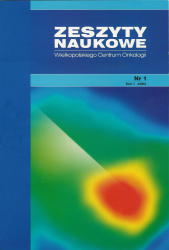Abstract
The aim of the article is to present current trends and reports on breast cancer brachytherapy presented during ESTRO 38 (38th European SocieTy for Radiotherapy and Oncology Annual Conference) which was held in Milan (Italy) in April 26-30th, 2019. The study includes concise information about the provided sessions, lectures, debates, oral presentations and recognized poster presentations focused on breast cancer treatment with brachytherapy.
References
Kaidar-Person O, Oldenborg S, Poortmans P. Re-irradiation and Hyperthermia in Breast Cancer. Clin Oncol (R Coll Radiol) 2018 Feb;30(2):73-84.
Forster T, Akbaba S, Schmitt D, et al. Second breast conserving therapy after ipsilateral breast tumor recurrence – a 10-year experience of re-irradiation. Journal of Contemporary Brachytherapy. 2019;11(4):312-319.
Cozzi S, Jamal D, Slocker A, et al. Second breast-concerving therapy with interstitial brachytherapy (APBI) as a salvage treatment in ipsilateral breast tumor recurrence: a retrospective study of 40 patients. J Contemp Brachytherapy 2019;11(2):101-107.
Hannoun-Levi JM, Resch A, Gal A, et al. Accelerated partial breast irradiation with interstitial brachytherapy as second conservative treatment for ipsilateral breast tumour recurrence: multicentric study of the GEC-ESTRO Breast Cancer Working Group. Radiother Oncol 2013 Aug;108(2):226-31.
OC-0318 10-year clinical and cosmetic outcomes of high-dose-rate brachytherapy for early breast cancer. Radiat Oncol 2019, Vol. 133 (Suppl. 1):S165.
OC-0319 Twelve years clinical outcomes with APBI with interstitial multicatheter brachytherapy after BCS. Radiat Oncol 2019, Vol. 133 (Suppl. 1):S165.
Guinot J, Gonzalez-Perez V, Meszaros N et al. OC-0321 Phase I-II multicenter trial Very Accelerated Partial Breast Irradiation (VAPBI): early effects. Radiat Oncol 2019, Vol. 133 (Suppl. 1):S166.
Strnad V, Ott OJ, Hildebrandt G, et al. 5-year results of accelerated partial breast irradiation using sole interstitial multicatheter brachytherapy versus whole-breast irradiation with boost after breast-conserving surgery for low-risk invasive and in-situ carcinoma of the female breast: a randomised, phase 3, non-inferiority trial. Lancet 2016 Jan 16; 387(10015):229-38.
SP-0343 Postoperative multicatheter brachytherapy. Radiat Oncol 2019, Vol. 133 (Suppl. 1):S173.
SP-0345 Single catheter balloon brachytherapy (Mammosite, Contura). Radiat Oncol 2019, Vol. 133 (Suppl. 1):S174.
SP-0346 Single catheter brachytherapy (SAVI) - Pitfalls, results and current recommendations. Radiat Oncol 2019, Vol. 133 (Suppl. 1):S174.
Coles CE, Griffin CL, Kirby AM, et al. Partial-breast radiotherapy after breast conservation surgery for patients with early breats cancer (UK IMPORT LOW trial): 5-year results from a multicentre, randomised, controlle, phase 2, non-inferiority trial. Lancet 2017 Sep 9;390(10099):1048-1060.
SP-0492 Radiobiology of APBI: aspects and limitations. Radiat Oncol 2019, Vol. 133 (Suppl. 1):S252.
EP-2119 HDR BRT boost in breast cancer: postoperative vs intraoperative procedurę, long-term outcomes. Radiat Oncol 2019, Vol. 133 (Suppl. 1):S1173.
EP-2123 APBI with Interstitial Brachytherapy versus Whole-Breast Irradiation for Early-Stage Breast Cancer. Radiat Oncol 2019, Vol. 133 (Suppl. 1):S1174.
EP-2118 Effects of interfraction uncertainty with Strut Adjusted Volune Implant applicator. Radiat Oncol 2019, Vol. 133 (Suppl. 1):S1172.
